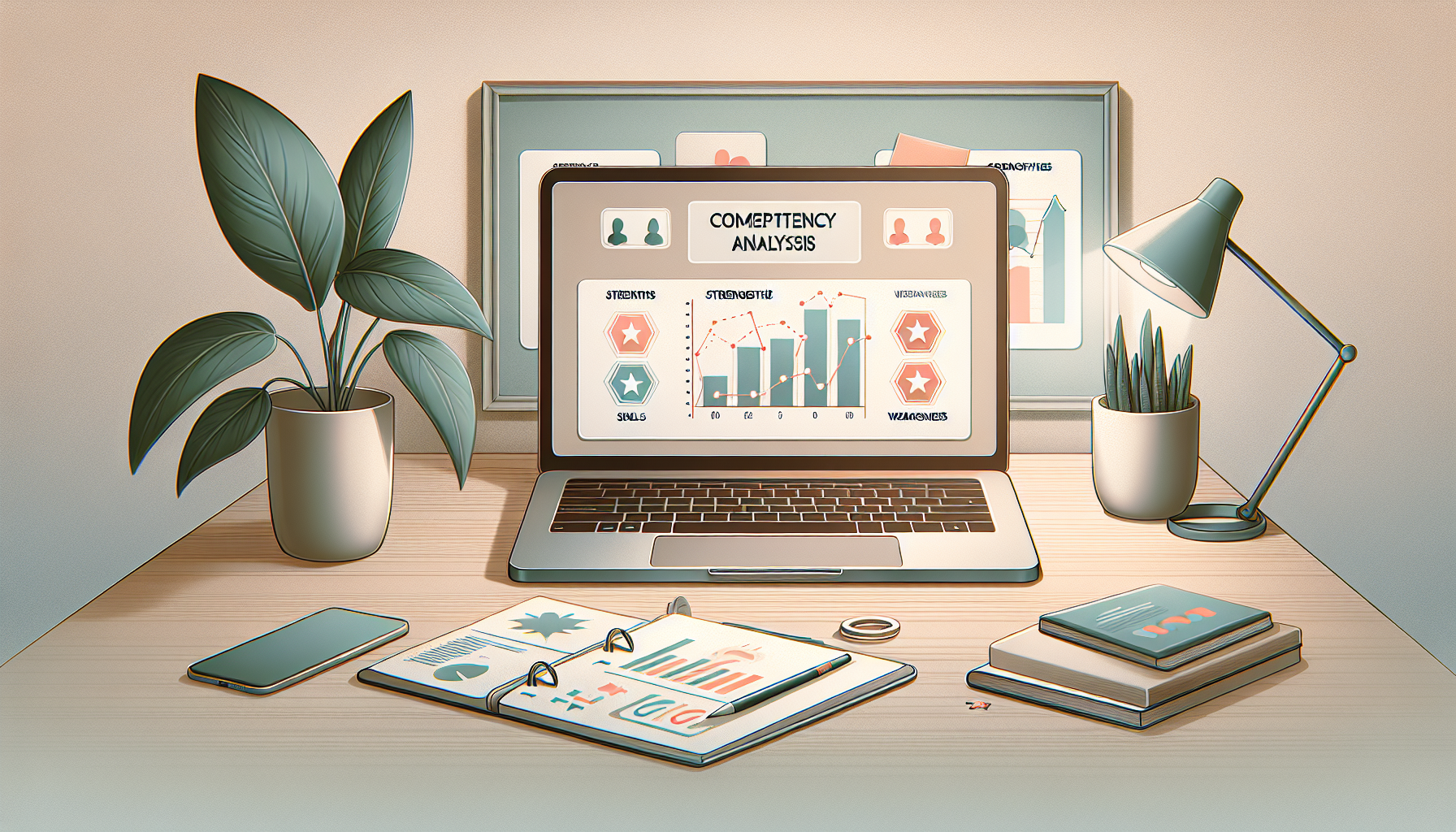Competency mapping can feel pretty overwhelming, can’t it? With so many skills and qualifications to consider, it’s easy to get lost in the shuffle. You might be wondering how to approach it effectively, especially when you’re trying to ensure your team’s abilities align with your organization’s goals.
But what if I told you that there’s a way to simplify the process? If you stick around, you’ll discover how to leverage ChatGPT’s prompts to create a streamlined competency mapping strategy that suits your needs perfectly.
We’ll explore some handy prompts, dive into key competencies, and even highlight common pitfalls to avoid. By the end, you’ll be equipped to enhance employee development like a pro!
Key Takeaways
- Competency mapping helps align team skills with organizational goals.
- Use specific ChatGPT prompts to identify key competencies for various roles and industries.
- Create a competency framework by organizing competencies into categories like technical and leadership skills.
- Avoid common mistakes by engaging stakeholders and utilizing data-driven insights.
- Competency mapping enhances employee development by linking roles with required skills and improving training programs.

Best Prompts for Competency Mapping with ChatGPT
Getting started with competency mapping through ChatGPT can be as easy as typing a few effective prompts.
Here are some targeted prompts you can use to get meaningful insights.
- “List the key competencies required for [specific job title] in [industry].”
- “Generate a competency framework for an employee in the [specific department].”
- “Identify the top 5 soft and hard skills needed for [specific project].”
- “Provide a detailed competency assessment checklist for [role or industry].”
- “Suggest best practices for developing competency matrices for [specific function].”
These prompts help in identifying effective competencies relevant to your organization’s needs.
How to Create a Competency Mapping Framework Using ChatGPT
Creating a competency mapping framework with ChatGPT involves a few straightforward steps.
First, define the job roles or functions for which you want to create competencies.
Then, use ChatGPT to brainstorm various competencies related to those roles.
For instance, prompt, “What competencies should be included in a competency map for a [specific job role]?”.
Next, organize the specified competencies into categories like technical skills, leadership qualities, and industry-specific requirements.
Finally, validate your framework by seeking feedback via prompts like, “Assess the relevance of these competencies for [role or function] and suggest improvements.”
This systematic approach can help ensure that the competencies align well with your organization’s culture and business goals.
Key Competencies to Include in Your Mapping
When performing competency mapping, it’s essential to cover both hard and soft skills.
Start with core competencies that every employee should possess, like communication and problem-solving skills.
Then, list technical skills relevant to specific roles, such as coding for IT professionals or financial analysis for accountants.
Don’t overlook leadership competencies, especially for managerial positions; skills like conflict resolution and team motivation are critical.
Also, think about industry-specific competencies; for example, compliance knowledge is vital in finance and healthcare sectors.
For behavioral competencies, include items like adaptability and teamwork to create a comprehensive map.
Examples of Competency Mapping Prompts for Various Industries
Industries have unique competency needs, and prompts can help uncover those.
For healthcare, ask, “What competencies are essential for a nurse in [specific department]?”
In finance, try, “Identify the key skills for a financial analyst working with investment portfolios.”
In IT, use, “Generate a list of competencies for a software developer focusing on [specific technologies].”
Manufacturing professionals may benefit from this prompt: “What competencies are necessary for a quality assurance engineer?”
Finally, for education, a useful prompt could be, “List competencies required for a high school teacher in [specific subject].”
Using these industry-specific prompts can guide you in compiling the right competencies for your mapping needs.

Using ChatGPT to Analyze Competencies Effectively
Leveraging ChatGPT for analyzing competencies can streamline the assessment process.
To kick things off, prompt ChatGPT with, “Analyze the competencies of a successful [specific role] and list strengths and weaknesses.”
This helps you understand what works and what needs improvement.
For a deeper dive, try, “Provide a skills gap analysis for [specific job title] based on the following competencies: [list competencies].”
This way, you can pinpoint areas for development within your team.
Want to understand trends in competencies? Use the prompt, “Identify emerging skills in [industry] and explain their relevance.”
ChatGPT can also summarize feedback by using, “Compile feedback from [specific group] on their competency performance.”
By requesting actionable insights, you’ll make data-driven decisions that can enhance your HR strategies.
Tips for Customizing Prompts to Fit Your Organization’s Needs
Customizing prompts for your organization ensures you’re getting relevant and actionable insights.
First, think about your company values and culture, then modify prompts like, “List competencies that align with our company values of [insert values].”
You can also be specific about your personnel needs by asking, “Generate a competency map for a [specific position] in [specific department].”
Another effective prompt is, “Suggest competencies for leadership roles that reflect our business goals related to [specific goals].”
Don’t forget to review the language; using concise and clear commands enhances results.
A prompt like, “What unique skills should we seek for roles in our [specific sector]?” can yield tailored insights to fit your niche.
Tailoring these prompts helps in better aligning ChatGPT’s outputs with your organization’s specific context.
Common Mistakes to Avoid in Competency Mapping
Avoiding common pitfalls in competency mapping can save time and improve your process significantly.
First, don’t neglect to engage key stakeholders. Prompt ChatGPT with, “List stakeholders we need to engage for competency mapping in [specific department].”
Another big mistake is overlooking critical competencies; inquire with, “Identify potential overlooked competencies for [specific job].”
Failure to use data-driven insights is also an issue; ask, “What data should we collect to validate our competency models?”
Remember the importance of continuous improvement; utilize ChatGPT to ask, “How can we refine our existing competency mapping process?”
Lastly, clearly communicate the purpose of mapping by prompting, “Explain the importance of competency mapping to our team.”
Avoiding these mistakes can enhance the effectiveness and acceptance of competency mapping in your organization.
How Competency Mapping Can Enhance Employee Development
Competency mapping is a powerful tool for boosting employee development.
It clearly links roles with required skills, so start with, “Explain how competency mapping contributes to career development for [specific job role].”
To improve your training programs, prompt ChatGPT with, “Suggest training programs based on the following competencies: [list of competencies].”
Engagement can be boosted by using, “How does a comprehensive competency map improve employee motivation in our company?”
Not only does it provide clarity, but it also fosters communication about performance using prompts like, “Generate a performance review template based on mapped competencies.”
By aligning competencies with organizational goals, you can use, “List strategies for integrating competencies into employee career paths.”
Such practices can significantly enhance growth opportunities within your workforce.

Integrating ChatGPT Prompts with Existing HR Tools
Integrating ChatGPT prompts with your existing HR tools can greatly streamline your competency mapping process.
Start by evaluating your current HR software and identifying areas where AI can add value.
For example, use the prompt, “Suggest prompts for integrating ChatGPT with our current HR system for competency mapping.”
This can reveal ways to combine traditional HR practices with innovative AI techniques.
Another effective prompt is, “How can we use ChatGPT to automate our competency assessment meetings in [specific tool]?”
Consider creating a central repository for prompts that all HR staff can access.
Using ChatGPT to generate reports can also be beneficial; try, “Create a monthly competency report template using data from our HR system.”
By employing these strategies, you’ll make your HR processes more cohesive and efficient.
Further Resources for Competency Mapping and ChatGPT
Having access to further resources can enhance your understanding and implementation of competency mapping with ChatGPT.
Start by asking, “List top online courses for competency mapping and AI tools in HR.”
This will provide you with valuable learning opportunities tailored to your interests.
Check out webinars too; prompt with, “Identify upcoming webinars focused on AI applications in competency mapping.”
Research articles can also provide deeper insights, so try, “Find recent studies that link competency mapping with employee performance.”
For case studies, use, “Share successful case studies of companies that implemented competency mapping using ChatGPT.”
These resources will solidify your understanding and help you apply competency mapping effectively in your organization.
FAQs
Competency mapping is the process of identifying, defining, and assessing the skills, knowledge, and abilities required for specific roles within an organization. It aims to align employee capabilities with organizational goals.
ChatGPT can generate prompts for competency assessment, provide tailored competencies based on industry needs, and assist in analyzing employee skills, making competency mapping more efficient and customized.
Common mistakes include failing to involve key stakeholders, using generic competencies, neglecting continuous updates, and poor communication about the competency framework, which can hinder its effectiveness.
Competency mapping identifies skill gaps and development needs, enabling targeted training and career advancement paths. This aligns employee growth with organizational goals, enhancing overall performance and job satisfaction.
